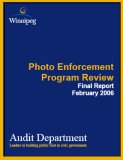3/24/2006
Winnipeg, Canada Report Shows Accidents Increased with CamerasIndependent city audit shows Winnipeg, Canada police use misleading statistics to hide the increase in accidents caused by photo enforcement.

An official audit of the Winnipeg, Canada photo radar and red light camera system shows that the city used misleading statistics in an attempt to cover-up the program's failure to reduce accidents. Independent evidence cited in the report released to the public Wednesday indicates that the number of insurance claims for accidents, injuries and property damage expenses went up significantly at sites using camera enforcement in the year following the introduction of the devices.
Provincial law requires that Winnipeg Police Service conduct an evaluation of the safety effects of its photo ticket program. That evaluation claimed accidents dropped at the first twelve intersections to use cameras. Rear end collisions increased from 63 in 2003 to 84 in 2004 and 71 in 2005. Right angle collisions, however, dropped from 37 in 2003 to 15 in 2004 and 12 in 2005. On balance, the numbers looked positive.
Police data for the entire city, however, showed no change in the overall number of accidents. This raised a red flag for the auditor regarding the effectiveness of red light cameras in particular.
"The volume of right angle collisions, for the entire city, has remained relatively steady from 2002 to 2004," the audit stated. "This indicates that the change in driver behaviour observed at the original sites has not yet resulted in a change of behaviour at unmonitored sites."
Police did not provide data for the 12 other sites in use in 2004 or the six sites added in 2005.
To help explain discrepancies in the police data, the auditor sought accident claim numbers from Manitoba Public Insurance. The information provided for the twelve selected camera intersections paints a significantly different picture from the police version, and unlike the Winnipeg Police Service, there is no conflict of interest providing an incentive to skew the numbers in either direction.
"The information received is useful because it came from an independent source," the audit stated.
As seen in the charts, the number of collisions increased 58 percent after cameras were introduced at the twelve intersections selected by Winnipeg. These extra accidents were not minor ones. Injuries increased 64 percent and property damage claims between 60 and 113 percent, with the largest claims increasing the most. These effects were specific to the camera intersections, as the number of accidents citywide increased only 7 percent during the same period.
Prior to the audit report's release, police also consistently claimed a drop in the number of citations issued was evidence of the program's success in changing driver behavior. The Winnipeg Sun newspaper, for example, trumpeted the drop in an article on July 23, 2005:It's been 2 1/2 years since the city unveiled its photo enforcement program. In that time, Winnipeg police say they've noticed a promising decrease in the number of red-light and speeding violations. "The numbers are going down," said Const. Jackie Chaput, of the Winnipeg police photo enforcement unit. "We're happy to see that."The audit report shows the reason for the drop in citations was a disagreement with the union over the use of non-police personnel in the operation of mobile photo radar units. A resulting hiring freeze cut total deployments 18.8 percent below their full potential in 2004 (p. 27). With fewer operators, the number of mobile speed camera tickets plunged in 2004, but the decline only applied to the mobile sites requiring a human operator to move the cameras to a new location. The number of tickets from fixed speed and red light sites grew along with an increase in the number of cameras deployed.
In the first two years of the program, the machines issued 317,385 tickets and generated $17,661,636 (US $15,113,219) in revenue. This allowed the police service in 2004 to cut forty-six human police officers from the traffic unit. "There was also a significant reduction in the number of officers dedicated to this [traffic policing] function," the report states (p. 27).
Despite the numbers, the auditor believes it is too early to tell whether cameras will be a long-term benefit or detriment to safety.
Last month, a leaked version of the audit report stirred controversy over Winnipeg's contract with Affiliated Computer Services (ACS), which was so badly managed that the city failed to generate $49 million in expected revenue. ACS is charged with bribery for its effort to secure the photo contract in nearby Edmonton.
The full text of the report is available at the source link below in a 541k PDF file. View other red light camera studies.
Article Excerpt:
Source:
Collisions at 12 City Selected Sites 2003 2004 Change 202 320 +58%
Insurance Claims at 12 City Selected Sites Claim/Injury
Amount2003 2004 Change $0-$5000 447 717 +60% $5000-$10000 23 43 +87% $10000-15000 8 17 +113% Injuries 81 133 +64%
Regional News:
Other news about Canada
Permanent Link for this item
Return to Front Page


